Which bamboo is the fastest-growing and how long does it take to grow?
%22%20transform%3D%22translate(.9%20.9)%20scale(1.75781)%22%20fill-opacity%3D%22.5%22%3E%3Cellipse%20fill%3D%22%2391eeff%22%20rx%3D%221%22%20ry%3D%221%22%20transform%3D%22matrix(6.55898%2034.09887%20-97.12645%2018.68245%20212.7%200)%22%2F%3E%3Cellipse%20fill%3D%22%23080100%22%20rx%3D%221%22%20ry%3D%221%22%20transform%3D%22rotate(-173.9%20110%2063.4)%20scale(122.42652%2061.595)%22%2F%3E%3Cellipse%20fill%3D%22%239d9793%22%20rx%3D%221%22%20ry%3D%221%22%20transform%3D%22matrix(9.32384%20-36.1349%2085.21517%2021.98796%2069.7%2025.4)%22%2F%3E%3Cellipse%20fill%3D%22%2379baff%22%20rx%3D%221%22%20ry%3D%221%22%20transform%3D%22matrix(3.95919%2027.15427%20-67.39546%209.8265%20194.8%200)%22%2F%3E%3Cellipse%20fill%3D%22%232c2622%22%20rx%3D%221%22%20ry%3D%221%22%20transform%3D%22matrix(21.77888%20-33.28161%2018.87737%2012.353%20.1%20112.2)%22%2F%3E%3Cellipse%20fill%3D%22%23879487%22%20rx%3D%221%22%20ry%3D%221%22%20transform%3D%22matrix(-77.37674%208.88469%20-1.26128%20-10.98448%20194.2%2041.5)%22%2F%3E%3Cellipse%20fill%3D%22%230f0f0e%22%20rx%3D%221%22%20ry%3D%221%22%20transform%3D%22matrix(93.51537%20-3.96139%20.88974%2021.00391%20222.5%20126.1)%22%2F%3E%3Cellipse%20fill%3D%22%234a4845%22%20rx%3D%221%22%20ry%3D%221%22%20transform%3D%22matrix(-110.29246%2017.4225%20-2.88635%20-18.2719%20195.8%2086.4)%22%2F%3E%3Cellipse%20fill%3D%22%23aae2ff%22%20cx%3D%22170%22%20cy%3D%224%22%20rx%3D%2222%22%20ry%3D%2210%22%2F%3E%3Cpath%20fill%3D%22%23388b9e%22%20d%3D%22M261.9%2038.7L204.3%2030l23.4-10.7%2043.3-2.5z%22%2F%3E%3Cellipse%20fill%3D%22%23464646%22%20cx%3D%2282%22%20rx%3D%2214%22%20ry%3D%2218%22%2F%3E%3Cellipse%20fill%3D%22%234c4b4a%22%20rx%3D%221%22%20ry%3D%221%22%20transform%3D%22matrix(-18.38292%2058.00616%20-17.60665%20-5.57978%20112.2%20117.5)%22%2F%3E%3Cpath%20fill%3D%22%23848181%22%20d%3D%22M134%2056l-13-72-55%2087z%22%2F%3E%3Cpath%20fill%3D%22%233c3a3a%22%20d%3D%22M-2%20133.1l22.3%2016.6-36.3-79%2061.6%2020.9z%22%2F%3E%3Cellipse%20fill%3D%22%233e3e3b%22%20rx%3D%221%22%20ry%3D%221%22%20transform%3D%22rotate(-111.3%20145.9%20-39.2)%20scale(13.96291%2066.9058)%22%2F%3E%3Cpath%20fill%3D%22%2381827f%22%20d%3D%22M271%2041.7l-94%2015.9-12.6-19.9%2068-8.6z%22%2F%3E%3Cpath%20fill%3D%22%23676360%22%20d%3D%22M113%2059h100v18H113z%22%2F%3E%3Cellipse%20fill%3D%22%23635d59%22%20rx%3D%221%22%20ry%3D%221%22%20transform%3D%22matrix(21.9741%2020.12494%20-39.72848%2043.3789%2057%20116.9)%22%2F%3E%3Cellipse%20fill%3D%22%23635f5c%22%20rx%3D%221%22%20ry%3D%221%22%20transform%3D%22matrix(-6.38541%2016.36533%20-63.83227%20-24.90602%2028.8%2066)%22%2F%3E%3Cpath%20fill%3D%22%2368a0da%22%20d%3D%22M192.5%2026.5v-29h107v29z%22%2F%3E%3C%2Fg%3E%3C%2Fsvg%3E)
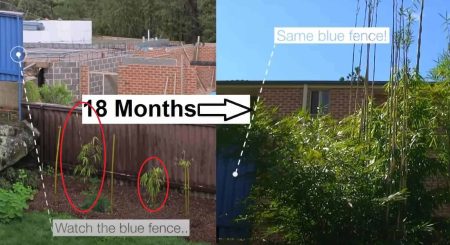
Slender Weavers (Botanical Name Bambusa Textilis Var. “GRACILIS”) Is By Far The Best Bamboo For Screening In Almost Every Case.
Reaching Only 6-8m, Easy To Keep Below That Height And Taking Up Such A Small Footprint It May As Well Have Been Designed By The Creator Of The Universe As A Gift To All People Who Have Just Moved In To A Nice House And Want Some Privacy In Their Yard.
The Time Taken To Reach Maturity Depends On The Size Of The Pot And How Well-Developed The Root System Is.
Any Slender Weaver’s Plant In A 200mm Pot Is Going To Take 2-3 Years To Reach Maturity. They Grow Faster And Bigger If You Space Them Out A Bit More (1.2m Is Good, 1m Is Too Close). A Lot Of People Look For The Biggest Plants In 200mm Pots. Some People Have Found Them (Not From Us, Ever) And After The Plants Had All Died Soon After Planting Saying “I Wish I’d Read Your Website Because It’s So Obvious When It’s Pointed Out.Large Plants In Small Pots = Rootbound And Stunted And At Its Worst, A Plant That Cannot Put New Roots Down And Won’t Grow Until Half The Roots And Half The Growth Have Been Removed To Give Them A Shock Into Getting Out Of The Stunted Phases They Have Been In.
Look At The Photo And Look At The Size Of The Plants, To Begin With.
Notice How Some Are Twice The Size Of The Others.
Notice How Some Have 3 Smaller Culms And Some Have 1 Large Culm.
Notice That They All Grow To Look The Same At The Same Time And That You Cannot Notice Any Difference.This Is Because The Roots Have Been Able To Get Down Quickly And Because They Are All Genetically Identical To Every Other Slender Weavers In The World.
%22%20transform%3D%22translate(1%201)%20scale(1.95313)%22%20fill-opacity%3D%22.5%22%3E%3Cellipse%20fill%3D%22%237bdaff%22%20rx%3D%221%22%20ry%3D%221%22%20transform%3D%22matrix(-124.67478%207.53413%20-4.4135%20-73.03462%20173.7%2026)%22%2F%3E%3Cpath%20fill%3D%22%2342382a%22%20d%3D%22M-13%2037l-3%20188%20287-54z%22%2F%3E%3Cellipse%20fill%3D%22%2367a8d8%22%20cx%3D%22107%22%20cy%3D%2274%22%20rx%3D%2250%22%20ry%3D%2250%22%2F%3E%3Cellipse%20fill%3D%22%23211a1b%22%20rx%3D%221%22%20ry%3D%221%22%20transform%3D%22rotate(-61.2%2080.2%2031.2)%20scale(48.86563%2028.60493)%22%2F%3E%3Cellipse%20fill%3D%22%237db6f4%22%20rx%3D%221%22%20ry%3D%221%22%20transform%3D%22matrix(-126.65177%20-17.99926%208.4895%20-59.73633%20174.3%2016.2)%22%2F%3E%3Cellipse%20fill%3D%22%23555246%22%20rx%3D%221%22%20ry%3D%221%22%20transform%3D%22matrix(16.1892%20-54.21933%2076.85732%2022.94862%20186%20147.3)%22%2F%3E%3Cellipse%20fill%3D%22%239b8b6d%22%20cx%3D%22214%22%20cy%3D%22254%22%20rx%3D%22215%22%20ry%3D%2254%22%2F%3E%3Cellipse%20fill%3D%22%23768814%22%20rx%3D%221%22%20ry%3D%221%22%20transform%3D%22rotate(174.5%2014.6%20128.5)%20scale(57.22388%2021.89704)%22%2F%3E%3Cellipse%20fill%3D%22%232f2e34%22%20rx%3D%221%22%20ry%3D%221%22%20transform%3D%22matrix(-.39206%2025.2697%20-39.45115%20-.61208%20180.6%20153.2)%22%2F%3E%3Cellipse%20fill%3D%22%234695a1%22%20rx%3D%221%22%20ry%3D%221%22%20transform%3D%22matrix(-94.45377%207.97134%20-1.0366%20-12.28296%20209.7%2091)%22%2F%3E%3Cpath%20fill%3D%22%23ace5ff%22%20d%3D%22M251.3%2049l-35-14.8L234.7-9l35%2014.9z%22%2F%3E%3Cellipse%20fill%3D%22%238d8475%22%20rx%3D%221%22%20ry%3D%221%22%20transform%3D%22rotate(-137.3%2018.4%205.2)%20scale(39.89157%2026.15684)%22%2F%3E%3Cellipse%20fill%3D%22%23707670%22%20cx%3D%2290%22%20cy%3D%22123%22%20rx%3D%2269%22%20ry%3D%2227%22%2F%3E%3Cellipse%20fill%3D%22%23327b8f%22%20rx%3D%221%22%20ry%3D%221%22%20transform%3D%22matrix(6.666%2032.89072%20-15.96644%203.23593%2066.8%2072.7)%22%2F%3E%3Cellipse%20fill%3D%22%236c666a%22%20cx%3D%2248%22%20cy%3D%22192%22%20rx%3D%22221%22%20ry%3D%2221%22%2F%3E%3Cellipse%20fill%3D%22%233c3f1a%22%20cx%3D%2295%22%20cy%3D%22161%22%20rx%3D%2251%22%20ry%3D%2210%22%2F%3E%3Cellipse%20fill%3D%22%23b8b7c1%22%20rx%3D%221%22%20ry%3D%221%22%20transform%3D%22matrix(.11213%20-10.7073%2017.22837%20.18042%20139.7%20250.6)%22%2F%3E%3Cellipse%20fill%3D%22%23090a0b%22%20cx%3D%224%22%20cy%3D%2282%22%20rx%3D%2223%22%20ry%3D%2218%22%2F%3E%3Cpath%20fill%3D%22%23554c36%22%20d%3D%22M-6%20270l-7-48%2050-5z%22%2F%3E%3Cpath%20fill%3D%22%239b8e89%22%20d%3D%22M270%20104l-89-6%2069%2024z%22%2F%3E%3C%2Fg%3E%3C%2Fsvg%3E)
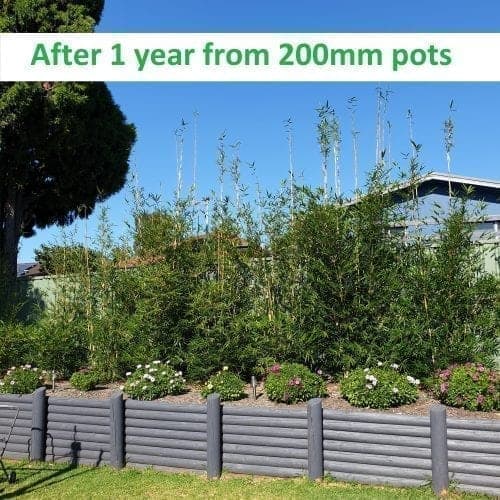
%22%20transform%3D%22translate(1.6%201.6)%20scale(3.21875)%22%20fill-opacity%3D%22.5%22%3E%3Cellipse%20fill%3D%22%237de9ff%22%20rx%3D%221%22%20ry%3D%221%22%20transform%3D%22matrix(-128.73111%208.32467%20-2.5033%20-38.71061%2073.8%2091.6)%22%2F%3E%3Cellipse%20fill%3D%22%232f481b%22%20rx%3D%221%22%20ry%3D%221%22%20transform%3D%22matrix(-101.18457%2013.64847%20-6.38173%20-47.31169%2035%20187)%22%2F%3E%3Cellipse%20fill%3D%22%232a0f15%22%20rx%3D%221%22%20ry%3D%221%22%20transform%3D%22rotate(169.3%2045.1%209.9)%20scale(128.81317%2024.89254)%22%2F%3E%3Cellipse%20fill%3D%22%23f8dce2%22%20rx%3D%221%22%20ry%3D%221%22%20transform%3D%22matrix(123.91948%20-34.36825%204.39802%2015.85768%2093.2%20249)%22%2F%3E%3Cellipse%20fill%3D%22%2381b643%22%20rx%3D%221%22%20ry%3D%221%22%20transform%3D%22rotate(108.9%20-17%2096.1)%20scale(23.05729%2046.03525)%22%2F%3E%3Cellipse%20fill%3D%22%232cc7f4%22%20rx%3D%221%22%20ry%3D%221%22%20transform%3D%22matrix(-1.5718%20-16.6279%2063.03943%20-5.95898%2074%2090.8)%22%2F%3E%3Cellipse%20fill%3D%22%23361b35%22%20rx%3D%221%22%20ry%3D%221%22%20transform%3D%22matrix(-59.86914%20-36.8278%2018.25555%20-29.67716%200%20187)%22%2F%3E%3Cellipse%20fill%3D%22%23ae978b%22%20rx%3D%221%22%20ry%3D%221%22%20transform%3D%22rotate(81.4%20-16.8%2052.5)%20scale(10.70034%20128.99998)%22%2F%3E%3Cellipse%20fill%3D%22%23e3dedf%22%20rx%3D%221%22%20ry%3D%221%22%20transform%3D%22matrix(21.25607%20-1.93105%203.57748%2039.37924%20125.1%20255)%22%2F%3E%3Cellipse%20fill%3D%22%232b984b%22%20rx%3D%221%22%20ry%3D%221%22%20transform%3D%22rotate(118.8%20-9%20111.2)%20scale(25.65171%2042.68312)%22%2F%3E%3Cellipse%20fill%3D%22%23786671%22%20rx%3D%221%22%20ry%3D%221%22%20transform%3D%22matrix(7.85849%2016.25607%20-41.10393%2019.87041%2088%20223.8)%22%2F%3E%3Cpath%20fill%3D%22%239bab99%22%20d%3D%22M0%20112h130v20H0z%22%2F%3E%3Cpath%20fill%3D%22%23ab9fa1%22%20d%3D%22M69.1%20271L-16%20254.8l25-14.6%2089%206.3z%22%2F%3E%3Cpath%20fill%3D%22%23a6dfff%22%20d%3D%22M119.4%2099.5l-37.5%204.8%2058.4%2019.9-2.1-24.6z%22%2F%3E%3Cpath%20fill%3D%22%23746569%22%20d%3D%22M89.9%2045.1l46.3-6.4L44.9%2030-9.8%2056.7z%22%2F%3E%3Cellipse%20fill%3D%22%232f7474%22%20rx%3D%221%22%20ry%3D%221%22%20transform%3D%22matrix(-59.6515%208.4044%20-1.59379%20-11.31216%20115.8%20188)%22%2F%3E%3Cellipse%20fill%3D%22%2333810f%22%20rx%3D%221%22%20ry%3D%221%22%20transform%3D%22matrix(3.0836%20-5.88221%2031.54654%2016.53751%2064.5%20166.7)%22%2F%3E%3Cellipse%20fill%3D%22%236f5365%22%20cx%3D%22124%22%20cy%3D%22158%22%20rx%3D%2213%22%20ry%3D%2221%22%2F%3E%3Cellipse%20fill%3D%22%236f6668%22%20cx%3D%223%22%20cy%3D%222%22%20rx%3D%2224%22%20ry%3D%2218%22%2F%3E%3Cellipse%20fill%3D%22%2374a8eb%22%20rx%3D%221%22%20ry%3D%221%22%20transform%3D%22matrix(-.64613%20-5.50022%2065.25619%20-7.66584%20107.5%2068)%22%2F%3E%3C%2Fg%3E%3C%2Fsvg%3E)

Which bamboo is the fastest-growing and how long does it take to grow?
Reaching only 6-8m, easy to keep below that height and taking up such a small footprint it may as well have been designed by the creator of the universe as a gift to all people who have just moved in to a nice house and want some privacy in their yard.
The time taken to reach maturity depends on the size of the pot and how well-developed the root system is.
Any Slender Weaver’s plant in a 200mm pot is going to take 2-3 years to reach maturity. They grow faster and bigger if you space them out a bit more (1.2m is good, 1m is too close). A lot of people look for the biggest plants in 200mm pots. Some people have found them (not from us, ever) and after the plants had all died soon after planting saying “I wish I’d read your website because it’s so obvious when it’s pointed out.
Large plants in small pots = rootbound and stunted and at its worst, a plant that cannot put new roots down and won’t grow until half the roots and half the growth have been removed to give them a shock into getting out of the stunted phases they have been in.
Look at the photo and look at the size of the plants, to begin with.
Notice how some are twice the size of the others.
Notice how some have 3 smaller culms and some have 1 large culm.
Notice that they all grow to look the same at the same time and that you cannot notice any difference.
This is because the roots have been able to get down quickly and because they are all genetically identical to every other Slender Weavers in the world.







Can I come and look at your bamboo?
Yes and no. We operate as an online nursery, which might sound a bit odd, so let me explain a few things so the answer is transparent and you feel comfortable, like you have been given a satisfactory and respectful answer.
Sydney Bamboo started with me, Matt, buying plants to do up our front yard. We needed a lot and I realised that I could buy in 10 packs, use 5 of them, grow the other 5 a bit until I got my money back. I bought other plants individually obviously, but by the end, hey presto, we got a front yard makeover for free.
Somewhere along the way, I picked up a bamboo plant which I paid almost no attention to, until it started putting up all of these shoots.
Then I realised each shoot was a baby plant in the right conditions and I am pretty good at working out the power of exponentiation. So, I could see that 2 plants after 1 year could be 4 plants after 2 years and 9 plants after 3 years and so on.
Then I realised I needed somewhere else to do this.
Shortly after, I noticed that when I told people where the plants were, they helped themselves and the business was, and still is, very small so public liability insurance was out of the question.
So, we don’t have a retail premises you can walk around like Bunnings.
Sometimes people come and pick up their orders.
If you would like to see the actual plants you are going to receive, please ask us to take some photos.
Very occasionally, we can deliver the plants ourselves.
Pick up can also be arranged so you can see what you are buying.
The other point to make is that all bamboo sold in nurseries like this are all clones. This means every slender weavers bamboo is genetically identical to every other slender weavers in the world.
They can look a bit different at the start, depending on whether they are cutting or division propagated.
However, after 6 months of growing, you won’t be able to tell the difference between them.
In other words, coming to look at our plants to decide which ones to buy is pointless because they are all the same.
Here is a gallery of slender weaver’s plants that were taken up to 8 years ago. If they are all still alive, they will look exactly the same in the same conditions.
If we had to run a retail premises our prices would have to increase to levels that would put us out of business.
I don’t know how the other nurseries stay in business with retail premises and Bunnings to compete with (though I don’t see a lot of bamboo there to be fair.)
Basically, we are good people and this is a family business, though some members are more reluctant than others.
Having a business is a fantastic way to show your kids how the world works a bit so we go to some effort to show them how it is run properly and how we treat customers.
If you feel we can or should do better please tell us because we are doing somethin wrong that we need to fix,
Depending on the situation you are very likely going to get a free plant or two.
S you can’t come and walk around but there are several ways you can see what you are buying before you pay. We will keep the panda out of your way.
FYI Pandas don’t eat any of the bamboos we sell, They eat mountainous bamboo species, mostly Fargesia spp. I believe. You can’t have a bamboo nursery without at least one Panda reference
Is Slender Weavers / Gracilis bamboo invasive / does gracilis bamboo spread?
Slender Weavers is a tight clumping bamboo. The clump will expand as more shoots come up. However the size of the clump takes years and years to reach more than 1m in diameter.
By that time you will need to remove some old growth anyway and at the same time you can cut out new shoots from the plants to keep them from getting too wide.
Generally they provide a screen without getting more than 50cm in diameter, usually less.
It is illegal to sell some running bamboos and we don’t sell any of them./
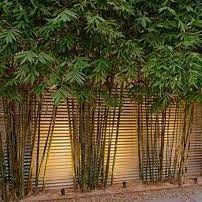

How far apart should I plant Slender Weavers / Gracilis bamboo?
Fewer plants mean a taller, nicer-looking screen, sooner. Counterintuitive until you think about it and then it’s common sense. It isn’t a way for us to sell more plants though, please notice that.
Leave about 50-75cm at the ends because the end plants will easily cover that.
You may well find you don’t need as many as you think.
You can stretch them out further if you want, particularly if you can cut the tops off some of the new culms, to force longer branches out lower down, and then you don’t even notice the gaps.
Gracilis, or Slender Weavers as it’s commonly called really is a bamboo that will suit almost any suburban project
does slender weavers bamboo drop leaves
More leaves need more water so keep the leaves to a minimum and you shouldn’t have a problem especially if you keep the soil mulched and let it improve with time
All bamboos can drop lots of leaves if they are in poor conditions AND left to grow too big. The key thing is to keep them to the minimum size you need and keep them thinned out to stop them from getting overcrowded.
The how to grow a hedge page explains how to do this.
The photos below show some Slender Weavers (Gracilis) which have been left to grow to the maximum size they can, and then some which have been left to get overgrown. These plants will drop more leaves in dry weather as they cannot supply enough water to the top of the clumps.
Look at how many culms there are!


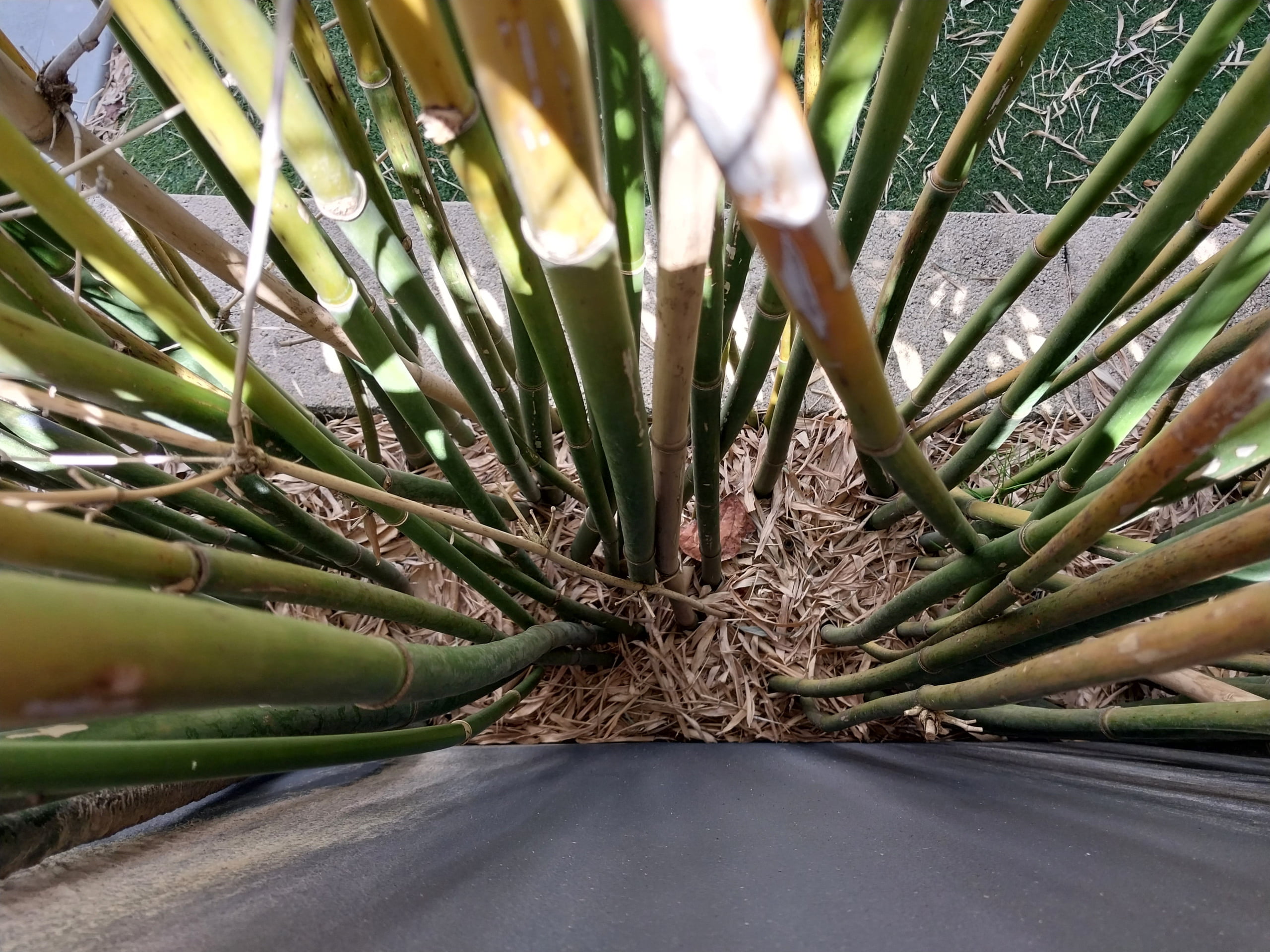

And look how despite that, they cannot put out enough leaves.
This soil does look particularly poor and it also looks like there is probably some kind of weed mat blocking the roots into the soil.
but with fewer culms, you get longer branches and more leaves.
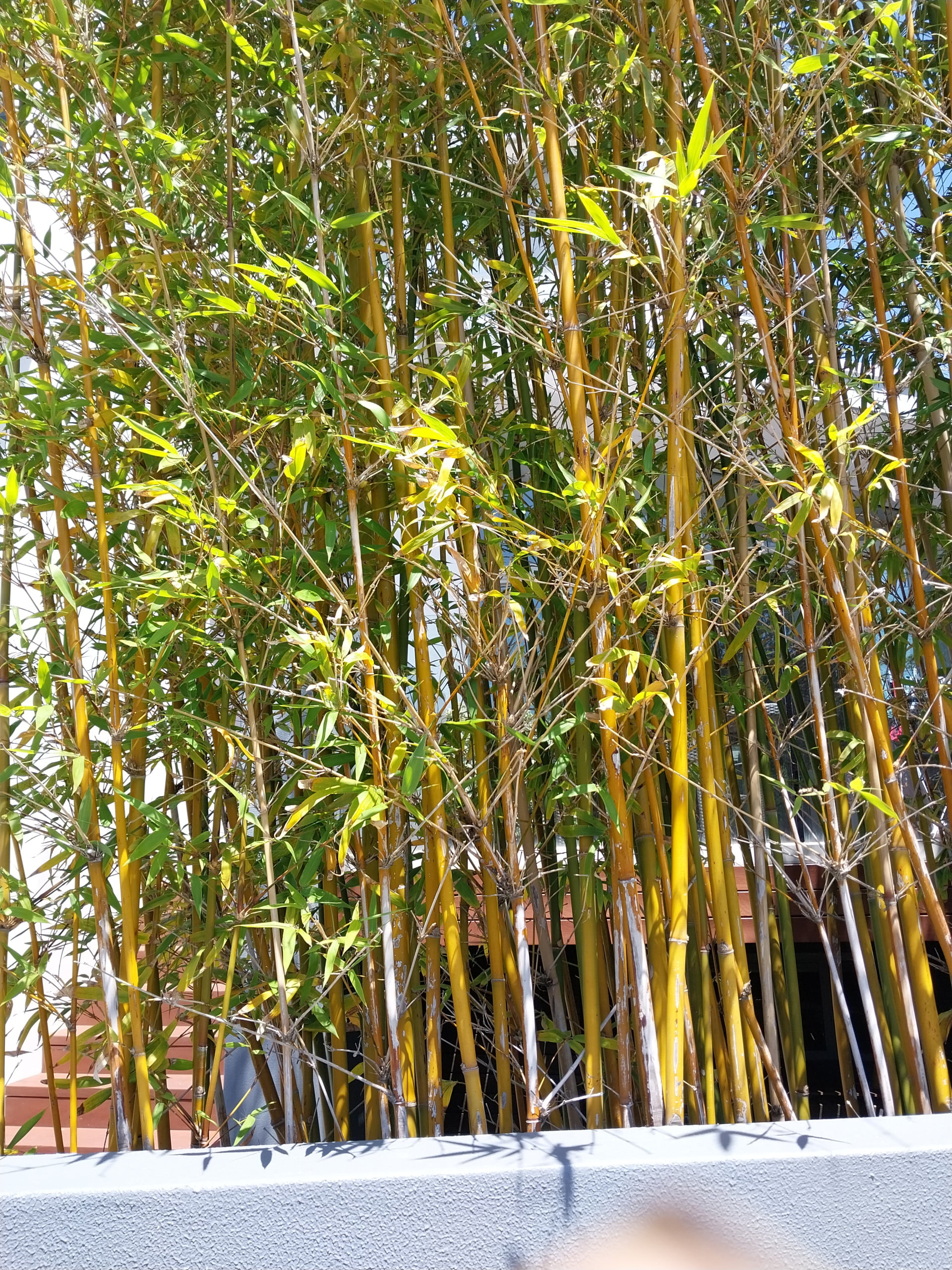





how long does gracilis bamboo take to grow?
Closer than that and they take longer because they compete with each other.


how to prune gracilis bamboo?
Remove new shoots when they emerge once the clump has provided a sufficient screen for you.
This shows new shoots and when to cut them.
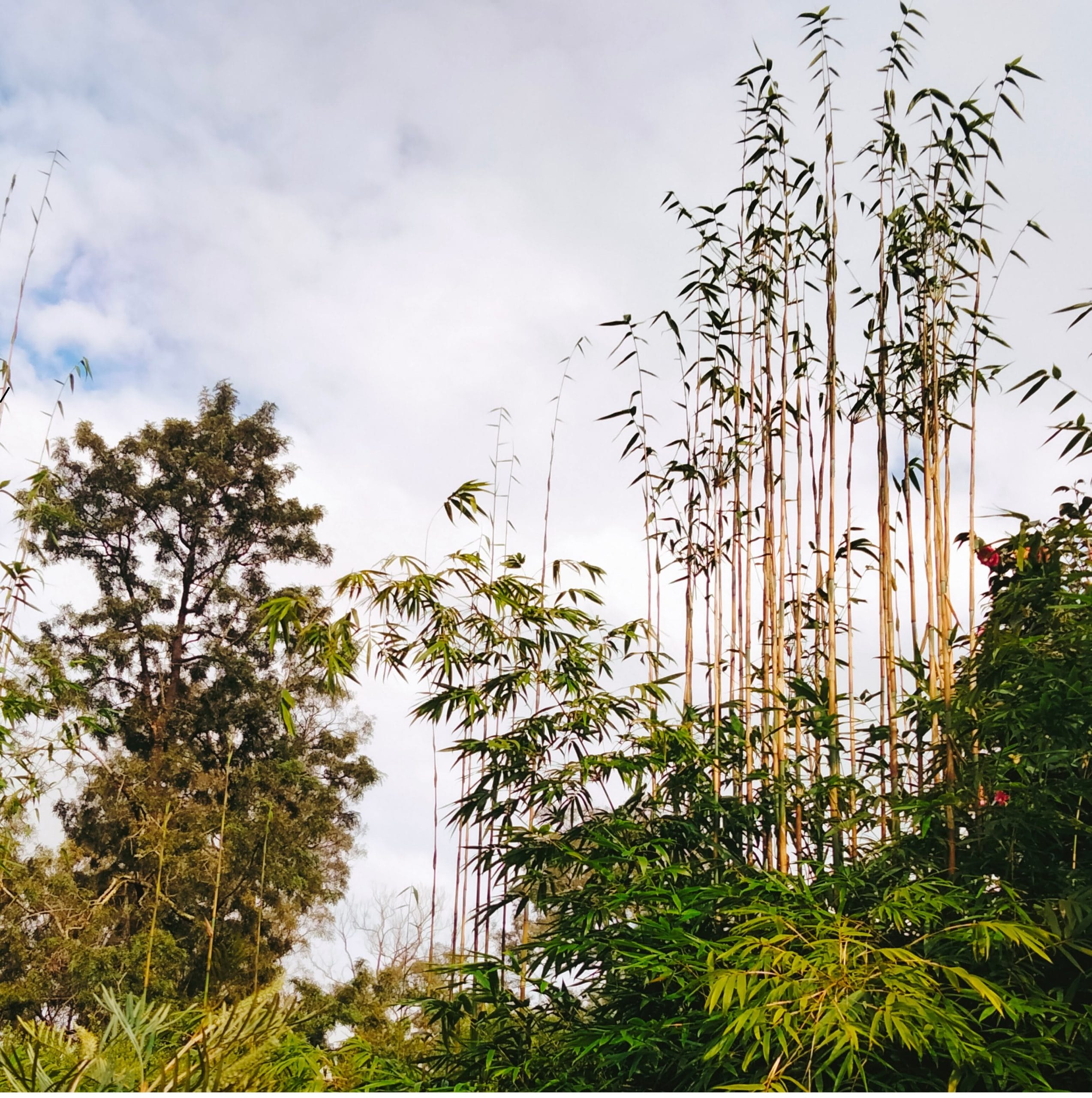







This is a way to tell when to cut the culms.
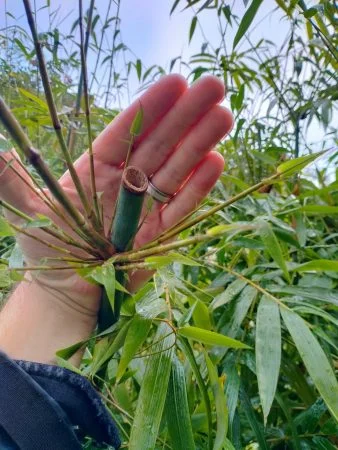

This shows how fast the branches form, for a more detailed explanation go to the How to Hedge page
Why is slender weavers bamboo used as a hedge
It is fast growing
Takes up little space
Stops at 6-8m
Can be kept shorter
Drought tolerant
Cold
Looks good all year round
Does not suffer pests and diseases
Is cheaper than and looks better than a colorbond fence
how wide does gracilis bamboo grow?
As soon as it has got big enough for you there is no reason to let more shoots come up unless you are replacing old ones.
Simply put a space down or break the shoots off with your hand.
How close should I plant Slender Weavers to get a quick screen?
Any closer together than 1.2m and they compete with each other and grow to be stunted with short branches and sparse foliage.
Planting 1.3m – 1.4m means the plant will grow faster and put up thicker, taller culms with longer branches and more leaves much sooner.
Why?
Because the area the plant can occupy is essentially a circle. The area increases with the square of the distance between the plants.
The volume occupied by the roots increases with the cube of the distance between the plants, as does the volume of air the leaves can occupy to absorb carbon dioxide.
Roughly speaking this means doubling the distance between the plants increases the sunlight it can absorb by four times as much and increase the water, nutrients and carbon dioxide by EIGHT times as much
.
Plant your bamboo further apart than you might be thinking because you will get a screen sooner that way, and you will have a screen made of much stronger, more vigorous bamboo which has a full display of foliage and it much more resistant to dry spells.
You will also save money that way.
The reason for saying this is the same as the reason for advising people NOT to buy the biggest plant in the smallest pot.!.
Somebody sent us a link to a nursery which quotes this
“. If your trench is a meter wide – plants should be spaced a meter apart – 500mm wide trench = 500mm spacing. Following that rule of thumb will provide you with a substantial screen…”
It’s really hard to know where to start with that but assuming the trench is 10m from front to back, they would be planted with 10cm spacing???
Planting them too close is the best way to low down the growth and end up with short bamboo with short branches.
We really do recommend 1.2m. It might seem like a lot but it really isn’t, with the culms diverging a tit, the plants only need to put out branches of 50-60cm to completely cover, and the average length of a branch is much more than that.
Please notice that we can explain our advice in terms that make sense (at least they do to us and that’s what people tell us)
Planting them closer together in a narrower strip??? That makes no sense..
The biggest thing that seems to be absent in that “logic” is that the plants will all grow to look the same in the same conditions, therefore there should be no reason to plant them twice as close together compared to the often quoted 1m, which is already pushing it…. they need space. they grow faster and bigger with more nutrients and sunlight (and carbon dioxide from the air, with more and bigger leaves). That’s not hard to understand.
Wherever you buy, make sure you ask questions because it keeps the market honest.
Are bigger bamboo plants better?
It is obvious to anybody who isn’t familiar with bamboo and doesn’t realise the 2 months time frame for all new shoots to reach their full height can completely change the height of a bamboo plant.
When the shoots that come out of the ground are only influenced by the size of the root system in the ground, it becomes much easier to see why the initial height might make a difference to the 1st shoot to come up, but compared to a whole growing season, it makes no difference at all if the plants have the same root system.
This is what the root system should look like in a healthy plant


Bamboo gets taller by putting put more and more shoots, each thicker and taller than the last. All of them take about 2 months to reach their maximum height.
It’s not at all unusual to see a plant from a 200mm pot put up a shoot that doubles the height of the pre-existing shoots.
Further, the root system can only support a certain number of leaves so the amount of growth coming out of the pot is going to be about the same as long as the plants are all equally developed.
Why do so many nurseries advertise the height and the number of culms as though taller and more culms is better?
Because most people don’t realise that bamboo grows completely differently than “normal plants” they look for the biggest plants they can find.
This means many nurseries grow the biggest plants they can in pots
This leads to people assuming that bigger is better.
What reasons are there to believe a bigger bamboo plant in a pot is better?
Before you read on, if you are new to bamboo, please think about this because it’s the easiest way to understand why there are no reasons at all to assume this.
Please read this carefully and please get back to us if there is anything that could be made clearer
How bamboo grows taller
Bamboo gets taller by putting up taller and taller culms, each of which stops growing at whatever height they get to (determined by the diameter at the base, which never changes) and are overtaken by the following one.
This means that when they are young they should have culms which gradually increase in height.
Every culm takes about 2 months to reach it’s full height before it stops growing and puts out leaves/
Then the next culm comes up and in 2 months it grows taller than the one before.
Once in the ground they put up multiple shoots together which always grow much taller than anything it could put up in a pot.
By the end of the second season they will have many shoots coming up, all at once which take 2 months to reach about 6m.
The 3rd season will be the time the bamboo has put up the tallest culms it can in the conditions it is in.
So, what does that mean about bamboo plants in pots that are only about 4.5L in volume?
What is going to happen if the plant is left in a pot that is 1000s of times smaller than the volume the roots could occupy in the ground?
This is what will happen.
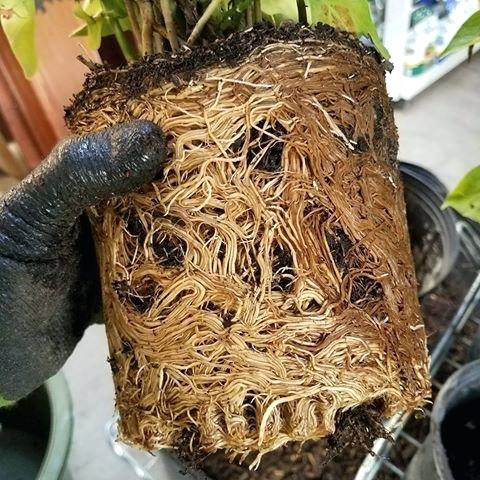

Most nurseries don’t bother to explain this and this means customers are looking for the biggest plants they can find.
The biggest plant you can find in a 200mm pot is something like the above
They are likely to have 6 culms all about 1.5m tall.
How is that possible if every culm should grow taller than the last?
Remember: Bamboo gets taller by putting up taller and taller culms.
Every culm that comes up is taller than the last.
A plant that has many culms the same height in a pot is clearly unable to grow properly.
Something is wrong.
The thing that is wrong is that the plant has run out of room to put out enough roots to support taller and bigger culms with leaves higher from the ground, needing water to be pumped up from the ground.
You can find plants like this in some nurseries and almost always they are sitting in a saucer of water or are being constantly drip fed water to prevent them from drying out.
They are rootbound and stunted and planting them in the ground will lead to them dehydrating very quickly.
The only way to keep them alive is to do as shown in the youtube (bottom link)
The next culm that comes up will be taller than the last (because that’s what every culm before it did)
If left in a pot it will put up another culm but it won’t reach much more than 1.5m
If put in the ground, the roots can occupy what is essentially an infinite volume and the next culm will be 2+m
A plant with a good root system is a plant that can put roots down easily.
A 200mm pot contains about 4.5L of potting mix.
A fully established, mature Slender Weavers will have roots that have grown a very, very long way and branched out to absorb moisture from as much soil as possible.
Furthermore, in the ground, the roots make connections with fungi in the soil which are connected to all plants and grow down as far as they can.
This is why plants in the ground, when established, can survive without water for months.
They are supplied by water deep underground from a vast network of fungi that form a symbiotic relationship with the roots.
The fungi give the plant water and nutrients from deeper than the plants can grow roots and the plants give the fungi sugars manufactured in the leaves via photosynthesis.
So… whenever you buy bamboo, make sure that it has culms that are different heights because that way, you know that the next culm is going to follow the same pattern and will grow taller.
Always inspect the roots if you are unsure and make certain that it is not showing signs of becoming rootbound.
Make sure the roots are not coiled up.
Never buy plants that are rootbound and stunted (click here)
Why is Slender Weavers so popular?
– very small footprint and can be planted in small areas
– a perfect bamboo plant for Sydney’s climate especially if you need privacy screening.
– extremely fast-growing
– Doesn’t get taller than 6-8m
– Frost hardy (down to below -10C)
– Drought hardy
– Easy to keep at a lower height
– Easy to maintain but cutting down and/or thinning out
– Looks good all year round
– very adaptable to a wide range of conditions
– easy to cut some culms to force leaves out at a lower height
– easy to keep looking neat and tidy if 8m and weeping tops is too big for you
It’s hard to think of any more qualities you want in a bamboo to screen the neighbour’s in 2 years.
How do I know your bamboo plants are as good as anywhere else?
This is what is means to have a variety or cultivar: a plant which is significantly different from the parent species discovered growing wild (variety) , developed in cultivation (cultivar)
Bambusa textilis = Parent species (12m tall)
Bambusa textilis var. ‘Gracilis’ = variety of Parent Bambusa textilis but only half the size yet incredibly fast to grow
Since all Slender Weavers (Gracilis) are propagated via cloning, you can expect any Slender Weavers from anywhere in the world to grow to look exactly the same as any other, in the same conditions.
This means our Slender Weavers are no different to any other, they just look different from each other here when they are small and in 200mm pots.
Put them in the ground or in big pots and you cannot tell the difference.
Is it worth buying Slender Weavers?
Is it worth spending about $70 for every 1.2m of this?




You can change it to look like this, if you like
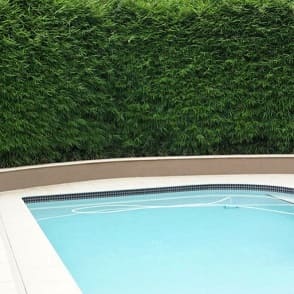

How much did the pool cost?
How much is a good price for the bamboo do you think?
Why are Slender Weavers plants so expensive?
The reason they aren’t cheaper is because they are extremely labour intensive to propagate, you only get a 2-3 week window once a year to propagate and nursing the propagules takes a high level of skill and a lot of time.
It also involves pretty much destroying a mature, very valuable clump and cutting it up into pieces, hoping they will stay alive which is a financial risk
Should I dig the soil over before planting bamboo?
If other plants are growing nearby in the same soil then it isn’t broken; don’t fix it.
That does not mean you can’t improve it by piling on manure, compost. blood and bone (not if you have dogs) and mulch but ONLY put that on TOP of the soil and let it break down, don’t dig it in because digging the soil breaks up the soil structure.
When seeds fall to the ground in nature, nobody is digging the soil up first.
Dead material accumulates on the SURFACE of the soil and gradually breaks down.
Aim to recreate the same conditions.
As the plant grows the soil will improve with it.
The ONE exception is during the first season.
How big are your Slender Weavers in 200mm pots?
Depending on how they were propagated they can have 3-6 culms on average.
Because they are all clones (genetically identical to every Slender Weavers in the World), they will all grow to look exactly the same.



How long does it take Slender Weavers to reach full height?
Because each shoot only takes 2 months to reach it’s full height, you will get faster-growing bamboo by starting with plants that are NOT rootbound and NOT overgrown and crowded in the pots.
A 1.5m plant will almost immediately put up a shoot that reaches in excess of 2m in 2 months.
A 2m plant in a 200mm pot = rootbound and means you may have to cut back significant amounts of roots and foliage to get it to survive and establish. It will take a long time to get going.
Take home message: don’t worry about how tall they are not, concentrate on buying plants that will establish easily and grow faster in the future.
They are all starting from the same-sized pot
The root system is well developed but not rootbound
Because they are all clones and grow at the same (extremely fast) rate and shoots only take 2 months to emerge from the soil and reach their full height, so a 1m plant now could be 2m in 4 weeks.
Is it worth spending 2 weeks looking for the biggest plants in a 200mm pot?
For one thing, 2 weeks is enough time for a hoot to almost double in size during the middle phase of growth.
Yes, you may find a small difference but the following affect the growth of the plant far more significantly than 20cm or 40cm difference in height in a 20mm pot
1- is the plant root bound (overgrown and too big for the pot)? If so, take it back and exchange it for a smaller plant with a healthy root system.
2- how was the plant propagated? Division or cutting? If you can get some 6 month old divisions in March then they can establish much, much faster than 18 month old cuttings half their size (good luck finding them)
3- How much room does the plant have because they tend to put out leaves to fill the space they are in.
This means spacing them out can have a dramatic effect on the speed that they grow
4- Do you have good soil with plenty of good organic fertiliser and mulch to encourage microbial activity?
5- In the ground the roots are connected to fungi which extend more or less infinitely.
If the foliage and culms are proportional to the root volume then the root volume of 200mm pot must be much less than 0.1% of the volume of soil accessed by the mature root of a plant.
If the foliage and culms are proportional to the root volume then the root volume of 200mm pot must be much less than 0.1% of the volume of soil accessed by the mature root of a plant.
Please consider what kind of plant you would expect to be able to develop and be happy in what is (for the plant) a very, very small pot with it’s roots restricted on all sides with plastic.
Would you want to buy plants that are struggling to stay alive in plastic pots and that had been kept in there too long, and were water three times a day to keep them alive in summer and which are actually unable to put out any new growth of significance?”
Or would you prefer plants that are happy and still actively looking to put out significant growth that once you put them in the ground, are able to take full advantage of the freedom and what will feel like an almost infinite amount of soil for the roots to grow into?
Do I need a root barrier for growing Slender Weavers
This way that shoot cannot develop to the stage it put up another shoot close to the fence and you always have a clear 20cm (or more) gap between the clumps of bamboo and a fence (or whatever)
How do I know the nursery I am buying bamboo from actually know what they are talking about?
Why do most nurseries advise planting Slender Weavers 1m apart?
We don’t advise planting them any closer than 1.2m.
Can I Grow Slender Weavers in Pots or Troughs?
If you are concerned about them spreading ever so slowly and eventually getting too big then large pots or troughs would work.
If you can cut the bottom off the trough or pot or at least make some large holes in the bottom, the roots will get into the soil and will look after the plant for you.
You won’t need to worry about maintaining all the micronutrients and they won’t need nearly as much water.
Allow at least 0.5 cubic m of growing media, and but only PREMIUM potting mix.
The local landscapers may have something cheaper but this is not the time so save money.
Premium potting mix is made to very exacting standards and if you don’t know the reason that Air Filled Porosity is important, you shouldn’t buy anything other than PREMIIUM potting mix because it’s made by and tested by people who understand a great deal more too.
It may seem a no brainer to fill the pots of troughs with soil but (generally speaking) that just doesn’t work and the plants will develop very poorly.
Note the difference between soil and potting mix. They are completely different.
Potting mix is entirely artificial in it’s design, it does not try to replicate soil. This is because pots are artificial and plants need adjustments made to the growing media to keep them happy (it’s complicated)
If the roots cannot get into the ground at all then the plants will be 100% reliant on you to keep them alive and happy and that means attention to detail and applications of slow release, full-spectrum fertiliser (N,P,K + Trace Elements) AND some calcium (gypsum or if you don’t have dogs blood and bone)
What do I do if I notice problems?
If the problem happened during delivery then take photos immediately and we will replace the plants free of charge.
All you need to do is take a photo of the plants as soon as you notice the damage.
Take photos of the plants, preferably whilst still secured in the box (it’s very easy to take photos of them in the box.)
Send the photos to sales@sydneybamboo.com.au
Explain what happened (you don’t need to go into lots of detail)
Then take the plants out of the box and sit them in water.
Then take photos the next day if they have not recovered.
Send the photos to us.
You will be sent new plants if they are in stock still, which is highly likely.
You will be refunded and offered a discount should you wish to purchase when they are in stock
Unless the plants are completely dead, we would just ask that you keep them alive until the courier can collect them and you will be sent new plants at no cost at all.
Can I pay over the phone or by bank transfer?
Your money will be handled by PayPal, AfterPay, Google, Apple or Stripe’s highly secure servers.
Your financial details never touch our servers as we don’t have $1m+ to pay for the security necessary to keep your details safe.
We do not take bank transfers because we are saying to you
“We have confidence in our product that we only take money with buyer protection”
Why are some leaves turning yellow?
The leaves which are going yellow are
1) all on the smallest, thinnest culms (canes)
2) the most yellow and discoloured the further back they are (if each set of leaves is a hand, the thumb is always the first to go yellow)
The reason they are turning yellow is because the plant is confined to a pot and it is about to put up some larger shoots.
We don’t over fertilise the plants which means that the plant is simply withdrawing nutrients from the oldest, lowest down leaves and diverting them to new growth which will be more useful to the plant
Where is Sydney Bamboo Located?
The one thing people get confused about is that there isn’t anything to see as we don’t have any mature specimens grown for their look.
They are all grown as mother plants.
However, because they are all clones and all the same clones as every other member of that particular species /variety /cultivar in the world, they can only grow one way so you can be sure that you will get what you want, it just takes a couple of years.
Wouldn’t I be better to look at them in pots?
As long as they are growing then they are healthy and as long as you look after them with basic plant care, they will grow as genetically programmed.
Looking at them in pots means you are looking at a plant that may reach 4m or it may reach 30m and you cannot tell the difference.
If you are unsure or are new to bamboo please feel free to give us a call and ask as many questions as you like.
Call Sydney Bamboo
Can I come to look at the bamboo at Sydney Bamboo?
That is all such bad karma that we decided to ever go there and only sell online.
That means you save heaps and get the plants delivered for almost nothing AND you don’t have to leave your home.
Does Sydney Bamboo provide help and advice
Does Bamboo need fertiliser?
Plants don’t “need” fertiliser. Go outside into the bush and take a look around.
Plants will grow faster and will generally look better and will have more resistance to stress if they have adequate nutrients.
Use organic fertiliser and avoid chemical fertiliser, except for the first season when you can use SLOW or CONTROLLED release fertliser with TRACE ELEMENTS.
This makes sure the plants have all the nutrients they need immediately, so they can establish quickly and put roots down deep enough to reach everything they need later on.
Osmocote Controlled Release All Purpose Fertiliser which contains trace elements has always been very good.
https://www.bunnings.com.au/scotts-osmocote-9kg-all-purpose- 3-1.8m.
Depending on how they were propagated they can have 3-6 culms on average.
Because they are all clones (genetically identical to every Slender Weavers in the World), they will all grow to look exactly the same.



Is it worth spending 2 weeks looking for the biggest plants in a 200mm pot?
For one thing, 2 weeks is enough time for a hoot to almost double in size during the middle phase of growth.
Yes, you may find a small difference but the following affect the growth of the plant far more significantly than 20cm or 40cm difference in height in a 20mm pot
1- is the plant root bound (overgrown and too big for the pot)? If so, take it back and exchange it for a smaller plant with a healthy root system.
2- how was the plant propagated? Division or cutting? If you can get some 6 month old divisions in March then they can establish much, much faster than 18 month old cuttings half their size (good luck finding them)
3- How much room does the plant have because they tend to put out leaves to fill the space they are in.
This means spacing them out can have a dramatic effect on the speed that they grow
4- Do you have good soil with plenty of good organic fertiliser and mulch to encourage microbial activity?
5- In the ground the roots are connected to fungi which extend more or less infinitely.
If the foliage and culms are proportional to the root volume then the root volume of 200mm pot must be much less than 0.1% of the volume of soil accessed by the mature root of a plant.
If the foliage and culms are proportional to the root volume then the root volume of 200mm pot must be much less than 0.1% of the volume of soil accessed by the mature root of a plant.
Please consider what kind of plant you would expect to be able to develop and be happy in what is (for the plant) a very, very small pot with it’s roots restricted on all sides with plastic.
Would you want to buy plants that are struggling to stay alive in plastic pots and that had been kept in there too long, and were water three times a day to keep them alive in summer and which are actually unable to put out any new growth of significance?”
Or would you prefer plants that are happy and still actively looking to put out significant growth that once you put them in the ground, are able to take full advantage of the freedom and what will feel like an almost infinite amount of soil for the roots to grow into?
Do I need a root barrier for growing Slender Weavers
This way that shoot cannot develop to the stage it put up another shoot close to the fence and you always have a clear 20cm (or more) gap between the clumps of bamboo and a fence (or whatever)
How do I know the nursery I am buying bamboo from actually know what they are talking about?
Why do most nurseries advise planting Slender Weavers 1m apart?
We don’t advise planting them any closer than 1.2m.
Can I Grow Slender Weavers in Pots or Troughs?
If you are concerned about them spreading ever so slowly and eventually getting too big then large pots or troughs would work.
If you can cut the bottom off the trough or pot or at least make some large holes in the bottom, the roots will get into the soil and will look after the plant for you.
You won’t need to worry about maintaining all the micronutrients and they won’t need nearly as much water.
Allow at least 0.5 cubic m of growing media, and but only PREMIUM potting mix.
The local landscapers may have something cheaper but this is not the time so save money.
Premium potting mix is made to very exacting standards and if you don’t know the reason that Air Filled Porosity is important, you shouldn’t buy anything other than PREMIIUM potting mix because it’s made by and tested by people who understand a great deal more too.
It may seem a no brainer to fill the pots of troughs with soil but (generally speaking) that just doesn’t work and the plants will develop very poorly.
Note the difference between soil and potting mix. They are completely different.
Potting mix is entirely artificial in it’s design, it does not try to replicate soil. This is because pots are artificial and plants need adjustments made to the growing media to keep them happy (it’s complicated)
If the roots cannot get into the ground at all then the plants will be 100% reliant on you to keep them alive and happy and that means attention to detail and applications of slow release, full-spectrum fertiliser (N,P,K + Trace Elements) AND some calcium (gypsum or if you don’t have dogs blood and bone)
What do I do if I notice problems?
If the problem happened during delivery then take photos immediately and we will replace the plants free of charge.
All you need to do is take a photo of the plants as soon as you notice the damage.
Take photos of the plants, preferably whilst still secured in the box (it’s very easy to take photos of them in the box.)
Send the photos to sales@sydneybamboo.com.au
Explain what happened (you don’t need to go into lots of detail)
Then take the plants out of the box and sit them in water.
Then take photos the next day if they have not recovered.
Send the photos to us.
You will be sent new plants if they are in stock still, which is highly likely.
You will be refunded and offered a discount should you wish to purchase when they are in stock
Unless the plants are completely dead, we would just ask that you keep them alive until the courier can collect them and you will be sent new plants at no cost at all.
Can I pay over the phone or by bank transfer?
Your money will be handled by PayPal, AfterPay, Google, Apple or Stripe’s highly secure servers.
Your financial details never touch our servers as we don’t have $1m+ to pay for the security necessary to keep your details safe.
We do not take bank transfers because we are saying to you
“We have confidence in our product that we only take money with buyer protection”
Why are some leaves turning yellow?
The leaves which are going yellow are
1) all on the smallest, thinnest culms (canes)
2) the most yellow and discoloured the further back they are (if each set of leaves is a hand, the thumb is always the first to go yellow)
The reason they are turning yellow is because the plant is confined to a pot and it is about to put up some larger shoots.
We don’t over fertilise the plants which means that the plant is simply withdrawing nutrients from the oldest, lowest down leaves and diverting them to new growth which will be more useful to the plant
Where is Sydney Bamboo Located?
The one thing people get confused about is that there isn’t anything to see as we don’t have any mature specimens grown for their look.
They are all grown as mother plants.
However, because they are all clones and all the same clones as every other member of that particular species /variety /cultivar in the world, they can only grow one way so you can be sure that you will get what you want, it just takes a couple of years.
Wouldn’t I be better to look at them in pots?
As long as they are growing then they are healthy and as long as you look after them with basic plant care, they will grow as genetically programmed.
Looking at them in pots means you are looking at a plant that may reach 4m or it may reach 30m and you cannot tell the difference.
If you are unsure or are new to bamboo please feel free to give us a call and ask as many questions as you like.
Call Sydney Bamboo
Can I come to look at the bamboo at Sydney Bamboo?
That is all such bad karma that we decided to ever go there and only sell online.
That means you save heaps and get the plants delivered for almost nothing AND you don’t have to leave your home.
Does Sydney Bamboo provide help and advice
Does Bamboo need fertiliser?
Plants don’t “need” fertiliser. Go outside into the bush and take a look around.
Plants will grow faster and will generally look better and will have more resistance to stress if they have adequate nutrients.
Use organic fertiliser and avoid chemical fertiliser, except for the first season when you can use SLOW or CONTROLLED release fertliser with TRACE ELEMENTS.
This makes sure the plants have all the nutrients they need immediately, so they can establish quickly and put roots down deep enough to reach everything they need later on.
Osmocote Controlled Release All Purpose Fertiliser which contains trace elements has always been very good.
https://www.bunnings.com.au/scotts-osmocote-9kg-all-purpose- landscape-controlled-release-fertiliser_p2980016
For the 1st season it’s a good idea to use this by digging it into the planting hole. It guarantees that all trace elements will be available for the plants to establish.
Did you know that plants need molybdenum as an essential element?
Do you know if your soil is boron deficient?
Any controlled / slow-release fertiliser with TRACE ELEMENTS will take care of that for you?
You can use if again for the second season if your soil is poor.
From the very beginning organic fertiliser gives good results. Blood and bone, well-rotted compost and manure are good organic fertilisers and should be applied annually to create healthy and resilient plants.
Avoid soluble fertiliser if you want healthy soil, and you REALLY want healthy soil because it contains all the bacteria and fungi your bamboo naturally lives with (symbiotic relationship) and they will do a great job of keeping your bamboo growing.
Look at soluble fertiliser as poison for healthy soil because that’s what it is.
If causes a flush of new growth followed by die back unless you add more and more of it.
At the same time it kills the microbes which live in the soil and help plants to extract nutrients from deep underground so the plants then become dependent on increasingly large applications of soluble fertiliser.
Is bamboo screening any good?
How long does a bamboo screen last?
Is Bamboo screening sustainable?
Is pruning bamboo difficult?
https://www.sydneybamboo.com.au/how-to-grow-a-clumping-bamboo-hedge
How can I tell how fast bamboo will grow?
Within 12 months the plant will have 3-4m culms and several of them. Another 12 months on and Slender Weavers bamboo will be mature at 6-8m
Does Bamboo Like Mulch?
How to mulch bamboo plants: Bamboo plants love mulch so regardless of adding anything else, always aim to use some mulch.
It modulates the soil temperature and moisture which is really beneficial for microbial activity.
We would recommend putting a thin layer now (1-2cm) while they are young and then when they are bigger you can increase the depth if you wish.
Keep the mulch topped up all around the plant.
This keeps the bamboo happy and it will put out more leaves, more quickly to form a screen.
More space means more growth and much faster growth.
How can you tell which bamboo you are buying
This is why you should only buy from a specialist bamboo grower an ask lots of questions/
It doesn’t matter so much that you understand the answers.
It matters that the person selling the bamboo sounds confident and fluent when talking about the bamboo.
Ask Q-“Why do some places recommend planting them close together and other nurseries recommend giving them more space?”
Q- “Did they propagate them themselves, do they have photos of their mother plants?”
If the answer is No then they are trusting someone else’s word
Q- “How do they know they are Slender Weavers?”
The mother plants had:
– Lack of hair on the culm sheaths,
– tightly clumping,
– more white/blue powder on new culms
Which bamboo is the fastest-growing?




How long does it take for a bamboo plant to grow?
Large plants in small pots = rootbound and stunted and at it’s worst, a plant that cannot put new roots down and won’t grow until half the roots and half the growth have been removed to give them a shock into geting out of the stunted phases they have been in.
Look at the photo and look at the size of the plants to begin with.
Notice how some are twice the size of the others.
Notice how some have 3 smaller culms and some have 1 lage culm.
Notice that they all grow to look the same in the same time and that you cannot notice any difference.
This is because the roots have been able to get down quickly and becaus they are all genetically identical to every other Slender Weavers in the world.



How tall are they and how many culms do they have?
It sounds better.
Nurseries make it sound better
It sounds obviously better.
It sounds obvious, it sounds better and it’s wrong.
Firstly notice how nowhere explains why it’s better.
The market is driven by how it sounds because most people are not familiar with bamboo and why would you be if you have never had any?
This is all factual and it explains why bigger, taller, bushier, more culms is not better.
Firstly the quickest answer is that it means a much higher chance of being rootbound and with clumping bamboo, new roots can only come from the top centre of the plant and cannot get through a 5cm mass of coiled roots.
The answer which proves that it’s wrong is that each culm grows taller than the last, taking 2 months to reach whatever height, whether it’s the 1st shoot on a new plant which reaches 50cm or a mature shoot on a tropical giant which reaches 30m.
Each culm is taller and wider than the last, the diameter being proportional to the height it will reach.
So, if a bamboo has been growing happily you should only see different sized culms.
If there are many culms all the same height in a pot then why?
The newest one should be taller than the last?
The reason is because the roots have run out of room in the pot and the plant is root bound.
The plant is also stunted (Bonsai effect) and the more culms the same height the worse especially with lots of leaves.
More leaves means higher rates of transpiration (water flowing from root hairs and straight out the stomata in the leaves). This means more roots, all coiled around in the bottom of the pot.
There is only one way to keep plants like that alive and it’s not for the novice grower.
A happy Slender Weavers in a 200mm pot should have 1, maybe 2 culms at about 1.5m and some smaller ones, all different heights. (Division propagated plants can put up 2 or 3 all at once and all to about 1.5m but then they need to go in the ground.)
Cutting propagated plants put up shoots something like 60cm, 90cm, 1.2m, 1.5m
Generally by the 4th-6th culm you have something about 1.5m.
What makes the biggest difference to how tall it’s going to be in the future?
How quickly it gets planted in the ground, that’s what makes the biggest difference.
Keeping it in a pot until it puts up more culms is going to result in problems.
A 200mm pot has almost no space compared to the total volume needed to support a plant to about 6m, especially when they mycorrhizae are taken into account.
You are comparing 4.5L or potting mix to 1,000s and 1,000s and 1,000s of L of soil (before even accounting for the the colonisation of fungi on the roots which supply all plants with more water than they can naturally reach which is why most plants in the ground don’t need watering once established.
Obviously they need to come from a similar climate.
We cannot emphasise this enough or say it enough times,
This may be new, it may come as a surprise and a shock but please notice that it does make logical sense.
Giving the roots enough space is really, really important.
Notice that these are the same reasons we recommend buying less plants spaced further apart and not more plants spaced closer together.
That way each plant gets more energy, water, nutrients, carbon dioxide and grows faster and gets bigger that way.
1m -> 1.2m spacing actually gives 44% extra surface area. The difference is significant when you watch them grow.
Notice this does make sense. It ma not be intuitive and it may not be what you were expecting to read, but it does make logical sense.
Notice how we are telling you about something that makes an even bigger difference with more space
Why are we writing this everywhere on the website: because we get people who tell us they wish they had known this when they’d bought plants that are now struggling.
They didn’t buy them from us but we will still help anyone who wants advice with bamboo.
Would you rather not know this?
Buy your bamboo wherever you like but please choose wisely
We are putting this out there to keep the market healthy to motivate people to supply bamboo which takes off once in the ground.
If this wasn’t true, why would we announce we won’t be selling the biggest plants you can find and convincing you to buy less of them???
Please feel free to contact us and explain why we’re wrong about young bamboo putting up a succession of taller and taller culms.
We’ve been doing since 2012 and if we have made a big mistake here, we will publicly apologise.
We have xperimented, a lot and found that it you thin the mature clums out and cut back 1/3rd of the culms, you end up with more leaves that leaving them to put up as many culms as they can to the maximum height they can.
Why? Well the plants can’t tell us but the ratio of above ground growth to the volume the roots can occupy consistently explains why less above ground growth means happier, more vigorous, more resilient bamboo (to a point.)
We are that confident we know what we are talking about, you can take a screenshot of this and it will always be in multiple places on the website.
If not then it will be a mistake so please tell us. If it isn’t published again and quickly you can come and take over the business if you wish.


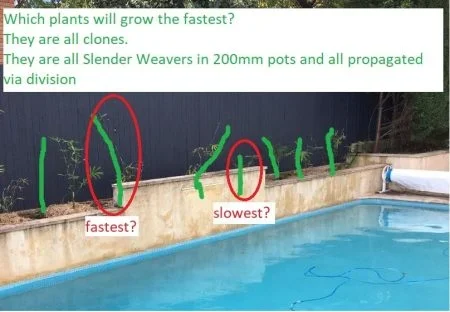

How much does Slender Weavers/Graclis bamboo gracilis cost?


How quickly does bamboo Slender Weavers / Gracilis grow?
All shoots take about 2 months to reach whatever height they are going to. In a 200mm pot they really can;t put up shoots much taller than 1.5m without putting strain on the root system, which does not enjoy being confined to a pot. Luckily they sell before they put but any more shoots, which is a good thing because it means the plants we sent out put up the next shoot in the ground where the roots can grow out to support a much taller shoot than you can ever see in a 200mm pot.
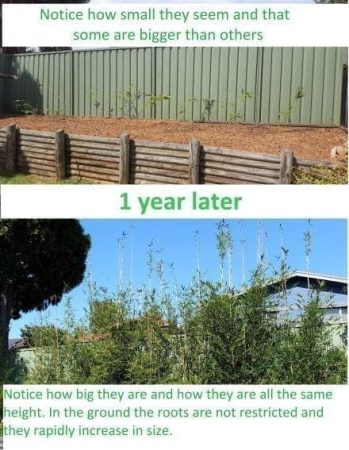

can gracilis bamboo grow in shade?
If you are looking to grow in shade, please note that what looks like shade on the round is often much better lit only 1-2m up.
Plants shaded by buildings grow surprisingly well because they still get scattered light from the sky and especially clouds.
Plants growing underneath heavily shaded trees are going to grow a lot more slowly.
In the shade of a gum tree, with filtered light they grow just as well, if not better, compared to in full sun.
Generally most bamboos are very adaptable to different conditions and beyond 3-4 hours of sun, no more makes any difference beyond causing excess moisture loss (which is why minimising the amount of leaves in the sun is always a good thing)
how to plant slender weavers bamboo?
Dif holes slightly bigger than the pot.
Plant the bamboo and backfill.
Cover with organic fertiliser and mulch and water.
For more detailed instructions see our care guidelines.
How can I get bamboo to have leaves from the ground up
This may look difficult to do but it really isn’t.
This is easy to achieve by cutting about 1.3rd of the culms to about 2m which forces branches out of the lower nodes.
This takes a few minutes, per plant, per year.
Then depending on how neat you need it to look a couple of times a year you can use some then a few times a year some hedge clippers. This will keep the hedge effect.
Clearing up is much easier than with a normal hedge as you will be sweeping up branches with leaves attached and not millions of leaves on their own.


how is clumping bamboo different to running bamboo?
Growth Pattern:
Clumping Bamboo: Clumping bamboo grows in tight, compact clumps or clusters. The rhizomes, underground stems that produce shoots, tend to stay close to the parent plant, resulting in a non-invasive growth pattern.
Running Bamboo: Running bamboo spreads through an extensive underground rhizome network, allowing it to grow aggressively and rapidly expand its territory. It sends out long rhizomes that can travel several feet or meters from the parent plant, resulting in a potentially invasive growth habit.
Spread and Containment:
Clumping Bamboo: Clumping bamboo has a relatively restrained growth habit and tends to stay within a confined area. The clumps gradually expand in diameter over time, but they don’t spread extensively unless actively divided or transplanted.
Running Bamboo: Running bamboo has a tendency to spread quickly and can become invasive if not properly contained. The rhizomes can travel underground and send up shoots in unexpected areas, making it challenging to control and potentially encroaching on neighboring plants or spaces.
Maintenance:
Clumping Bamboo: Clumping bamboo generally requires less maintenance compared to running bamboo. As long as it is given adequate space to grow, it tends to maintain its compact form and doesn’t require frequent containment efforts.
Running Bamboo: Running bamboo requires more management and maintenance to prevent its spread. Regular rhizome pruning or installing barriers, such as root barriers, can help contain the growth and prevent it from invading unwanted areas.
Planting Considerations:
Clumping Bamboo: Clumping bamboo is often preferred for smaller gardens or areas where containment is desirable. It works well as a focal point or a privacy screen without posing the same risks of invasiveness.
Running Bamboo: Running bamboo is typically suitable for larger landscapes where its rapid growth and spreading habit can be controlled effectively. It can be used for creating dense screens or windbreaks.
It’s important to note that while clumping bamboo is generally non-invasive, and running bamboo has a higher potential for invasiveness, there are variations within each type. Some clumping bamboos may have more spreading tendencies, and certain running bamboos may exhibit slower growth or have less invasive rhizome systems. It’s advisable to research specific bamboo species and cultivars to understand their growth habits and choose accordingly based on your needs and the available space.
What is the difference between the growth habit of running and clumping bamboos
Clumping Bamboo: Clumping bamboo grows in tight, compact clumps or clusters. The rhizomes, underground stems that produce shoots, tend to stay close to the parent plant, resulting in a non-invasive growth pattern.
Running Bamboo: Running bamboo spreads through an extensive underground rhizome network, allowing it to grow aggressively and rapidly expand its territory. It sends out long rhizomes that can travel several feet or meters from the parent plant, resulting in a potentially invasive growth habit.






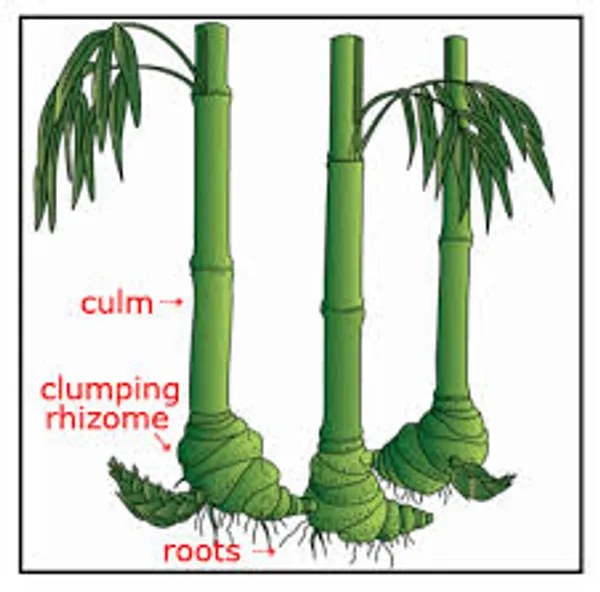


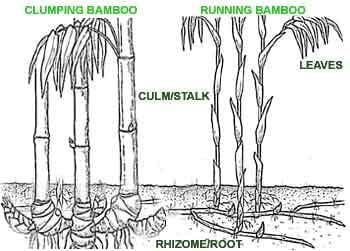


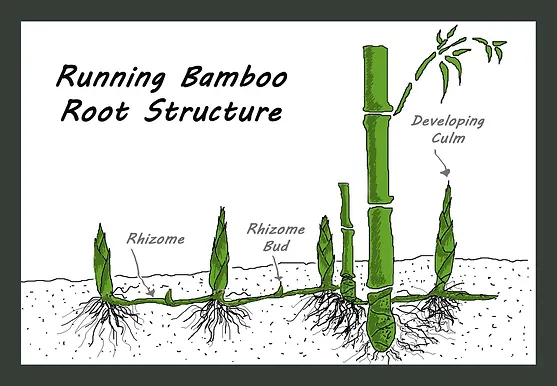


What is the difference between a bamboo rhizome and a bamboo root?
Definition:
Bamboo Rhizome: A rhizome is an underground stem that grows horizontally, sending out roots and shoots from its nodes. It is typically thick and fleshy and serves as a storage organ for nutrients and energy. Rhizomes allow bamboo plants to spread and produce new shoots.
Bamboo Root: Roots are specialized structures that primarily function to anchor the plant in the soil and absorb water and nutrients. They typically grow vertically downward from the base of the bamboo plant.
Structure and Appearance:
Bamboo Rhizome: Rhizomes are usually thicker and more robust compared to the roots. They have nodes and internodes, similar to the above-ground culms (stems) of the bamboo plant. Rhizomes are often interconnected, forming an extensive network underground.
Bamboo Root: Roots are generally thinner and more fibrous compared to the rhizomes. They lack nodes and internodes and grow straight down into the soil. Roots may branch out and spread in a radial pattern from the base of the bamboo plant.
Functions:
Bamboo Rhizome: Rhizomes play a crucial role in the vegetative propagation and expansion of bamboo plants. They enable the plant to generate new shoots by producing buds that develop into culms. Rhizomes also serve as a storage reservoir for nutrients, enabling the bamboo plant to survive adverse conditions and produce new growth in favorable circumstances.
Bamboo Root: Roots primarily serve to anchor the bamboo plant in the soil, providing stability against wind and other forces. They absorb water and nutrients from the soil, facilitating the plant’s growth and development.
In summary, bamboo rhizomes are underground stems that horizontally spread, produce new shoots, and store nutrients, while bamboo roots grow vertically downward, anchor the plant, and absorb water and nutrients from the soil. Both rhizomes and roots contribute to the overall health and growth of the bamboo plant, but they have distinct roles and characteristics.















How do I know if a bamboo plant is healthy
When examining a bamboo plant to assess its health, there are several key indicators you can observe:
Color and Vibrancy: Healthy bamboo plants generally have vibrant and rich green leaves. The color should be consistent throughout the plant, indicating good chlorophyll production. Yellowing or browning leaves can be a sign of stress or nutrient deficiencies.
Leaf Condition: Check the leaves for signs of damage, such as wilting, curling, or spots. Healthy bamboo leaves should be turgid, firm, and free from discoloration or significant pest damage.
NOTE: In pots and with young bamboo plants, the leaves always have a short lifespan.
It is common to see the older leaves dying off as the leaves higher up are forming, especially in spring
Growth Pattern: Look for new shoot growth. Healthy bamboo plants typically produce new shoots each year. The shoots should be upright, strong, and have a vigorous growth pattern. Weak or stunted shoot growth may suggest underlying issues.
Rhizome and Root System:
Assess the underground parts of the plant. Healthy bamboo rhizomes should be firm, plump, and free from rot or damage. The presence of numerous interconnected rhizomes indicates an actively spreading and robust bamboo plant. Healthy roots should be well-developed, white or cream-colored, and free from signs of decay.
Structural Integrity: Check the overall structure of the bamboo plant. It should be upright and stable, without any leaning or signs of weakness. Bent or drooping culms may indicate issues with the plant’s health.
Pests and Diseases: Look for signs of pest infestation or disease. Common pests that affect bamboo include aphids, scale insects, and mites. Symptoms of diseases can include leaf spots, discoloration, or wilting. Healthy bamboo plants generally have minimal pest or disease damage.
Environmental Factors: Consider the growing conditions and surroundings. Bamboo thrives in well-drained soil, adequate sunlight, and appropriate moisture levels. If the plant is in an unsuitable environment, it may exhibit signs of stress or poor health.
Remember that bamboo plants can have different growth habits and characteristics depending on the species, so it’s essential to familiarize yourself with the specific traits of the bamboo variety you are assessing. If you have concerns about a bamboo plant’s health, it’s advisable to consult with a local horticulturist or bamboo specialist for a more accurate diagnosis and guidance.
Why is Organic Fertiliser best for the soil
Nutrient Content: Organic fertilizers are derived from natural sources such as compost, manure, bone meal, fish emulsion, and other organic materials. These fertilizers contain a wide range of essential nutrients, including nitrogen (N), phosphorus (P), potassium (K), micronutrients, and organic matter. These nutrients are released slowly and gradually, providing a steady supply of nourishment to the plants without the risk of nutrient leaching or excessive runoff.
Soil Structure and Moisture Retention: Organic fertilizers improve soil structure and texture. The organic matter in these fertilizers enhances the soil’s ability to retain moisture, preventing waterlogging or excessive drainage. Organic matter also helps in building and stabilizing soil aggregates, promoting good soil aeration and reducing the risk of erosion.
Microbial Activity and Soil Health: Organic fertilizers contribute to the proliferation of beneficial microorganisms in the soil. These microorganisms, including bacteria, fungi, and earthworms, play a vital role in nutrient cycling, decomposition of organic matter, and overall soil health. They break down organic fertilizers into simpler forms that are readily available to plants, fostering a healthy and balanced soil ecosystem.
Long-Term Soil Fertility: Continuous use of organic fertilizers can lead to the buildup of organic matter in the soil. This accumulation improves the soil’s fertility and enhances its capacity to support plant growth over the long term. Organic fertilizers also help replenish depleted nutrients and trace elements, ensuring sustained productivity of the soil.
Environmental Sustainability: Organic fertilizers are environmentally friendly. They are typically derived from renewable resources, reducing reliance on synthetic and chemical-based fertilizers. Organic fertilizers have lower risks of polluting water bodies through nutrient runoff and are less likely to harm beneficial organisms, wildlife, and ecosystems.
Reduced Chemical Exposure: Organic fertilizers generally have lower concentrations of salts and chemicals compared to synthetic fertilizers. This reduces the risk of burning plant roots or causing damage due to over-application. Additionally, organic fertilizers do not contribute to the accumulation of chemical residues in the soil or food chain, promoting safer and more sustainable agricultural practices.
It’s worth noting that the effectiveness of organic fertilizers can vary depending on factors such as nutrient content, application rates, soil conditions, and specific crop requirements. Understanding the nutritional needs of your plants and the characteristics of your soil can help in selecting and using the most appropriate organic fertilizer for optimal results.